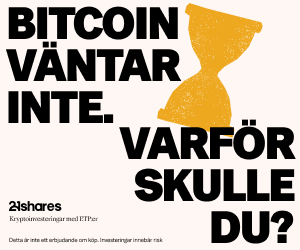Nyheter
Fundamental Improvements in the Aftermath, What’s Next?
Publicerad
2 år sedanden
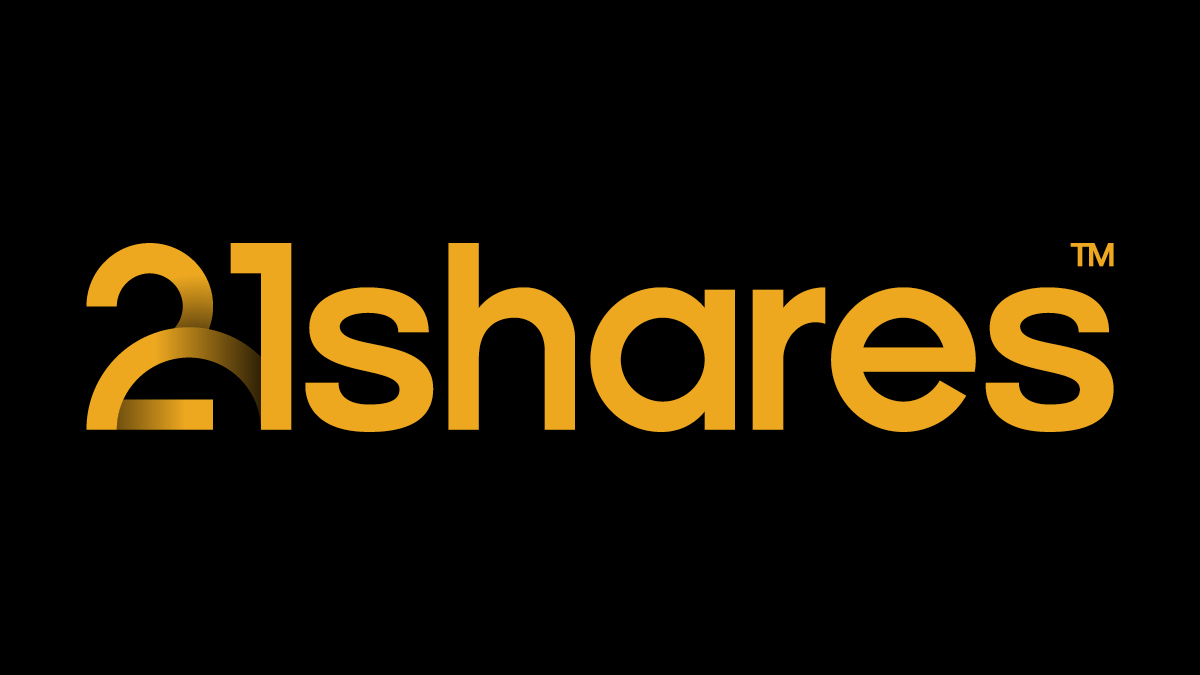
Markets reacted in opposite directions this month, as regulating the cryptoasset industry is still in talks in the U.S. New developments in the Ripple case spurred some optimism, with the hope that the long tail of cryptoassets may not be considered crypto-securities. Bitcoin and Ethereum fell by almost 4% each over the past month. However, the market cap of the decentralized finance (DeFi) industry alone has increased by 8%. As shown below, the biggest winners of July were Maker, which increased by 50% in returns, Solana (+28%) came in second, and thirdly Optimism (+ 21.8%). These jumps in price movements can be attributed to fundamental improvements and developments in both the application and infrastructure layers, which we will elaborate on later in this monthly review.
Figure 1: Price and TVL Development of Major Crypto Sectors
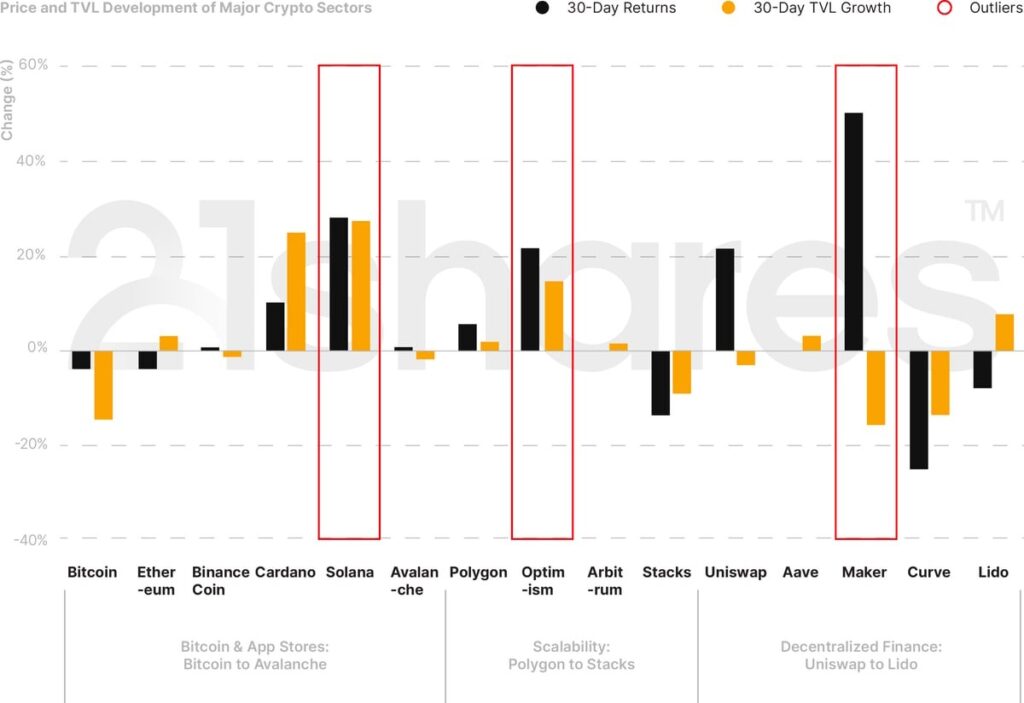
Source: 21shares, CoinGecko, DeFi Llama. Data as of July 30 close.
5 Trends to Remember from July
• XRP by itself may not be a security, according to a U.S. court decision.
On July 13, U.S. District Court Judge Analisa Torres issued a summary judgment order that was partly in favor of the Securities and Exchange Commission (SEC) and partly in favor of Ripple. Specifically, Judge Torres distinguished between the target of an investment contract (e.g., XRP as a token) versus the sale and marketing of that asset (e.g., the investment contract around the sale or offer of XRP). The former was not held to be a security, but the latter was in certain circumstances. Judge Torres’ decision also held that there were disputes of material fact that were not appropriate to resolve on summary judgment, so there could be a trial relating to a few additional issues (including whether Ripple’s founders aided and abetted Ripple’s securities law violations). Although not conclusive, the court’s decision spurred short-lived optimism across the cryptoassets market. On July 13, Bitcoin reached $31.45K, the highest since May 2022. Ethereum, on the other hand, surpassed the $2K, a level last seen in April following the Shanghai upgrade. As for the industry’s long tail of tokens, especially those labeled in previous SEC lawsuits (against Coinbase and Binance) as securities, Solana, Polygon, and Cardano all enjoyed roughly 30% increase in returns for the two days following the verdict.
Hoping it would mean the same for the collapsed Terra Luna, Terraform Labs filed a motion to dismiss their case based on Judge Torres’ “programmatic sales” argument. On July 21, the lawyers for the SEC filed a response against Terraform’s motion, vaguely suggesting that they’re considering an appeal against the Ripple court decision. Judge Jed Rakoff rejected Terraform’s motion at the end of the month, saying that the court rejected the approach adopted by Judge Torres in the Ripple case. While this may not change XRP’s ruling, it may affect the market sentiment of the token, which has persevered as of writing this report, still enjoying the 40% increase over the past month.
• MakerDAO: A Return to Fundamentals
Maker also implemented the enhanced DAI savings rate (eDSR), first increasing the yield to 3.49% in June, while a subsequently approved proposal in late July switched the interest rate into a dynamic model that could potentially see the yield reach 8%. Thus, eDSR could catalyze the adoption of DAI as the deposit rewards could surpass the risk-free benchmark of traditional finance, represented by the US treasury at 4%, and help to establish an attractive savings rate that could improve the liquidity of DeFi. This isn’t to argue that Maker’s deposit rewards would be considered a safe investment compared to the risk-free rate of the US Treasury, as the US government is the sole lender of last resort, but it does show the measures DeFi protocols are adopting in order to compete and build a sustainable treasury leveraging the current macro environment. Although temporary, elevated interest rates present a valuable window for projects to capitalize on, fostering lasting treasury growth. Finally, Maker’s shift towards real-world assets (RWA) is proving fruitful, generating around $90M in annual revenue, with more than 50% exposure.
Figure 2: Revenues per Type
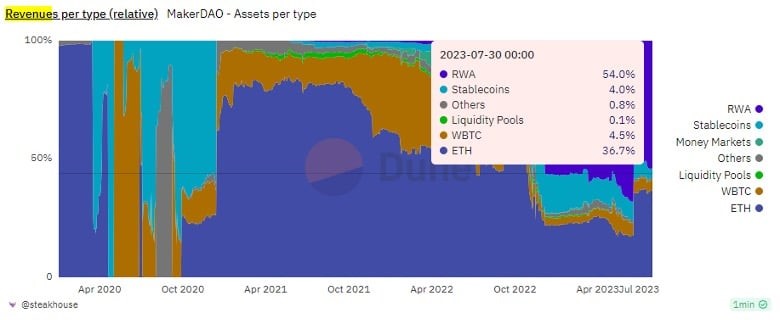
Source: Steakhouse on Dune
This growth is significant as it provides a practical revenue generation approach without relying solely on token emissions. It also showcases the benefits of bridging with the TradFi, encouraging other protocols to build sustainable treasuries for runway protection during times of volatility. Furthermore, the increase in DAI’s savings rate elevates DeFi’s stablecoin yield benchmark, incentivizing protocols to become more competitive and driving further user adoption. It is worth noting that DeFi tokens outperformed the market in July, potentially forming a bottom for the first time in almost two years. So, we’ll be closely observing Maker’s impact on the broader sector and how it could influence their decision to further integrate with TradFi.
Figure 3: Price Indices Performance of the Different Ethereum Industries
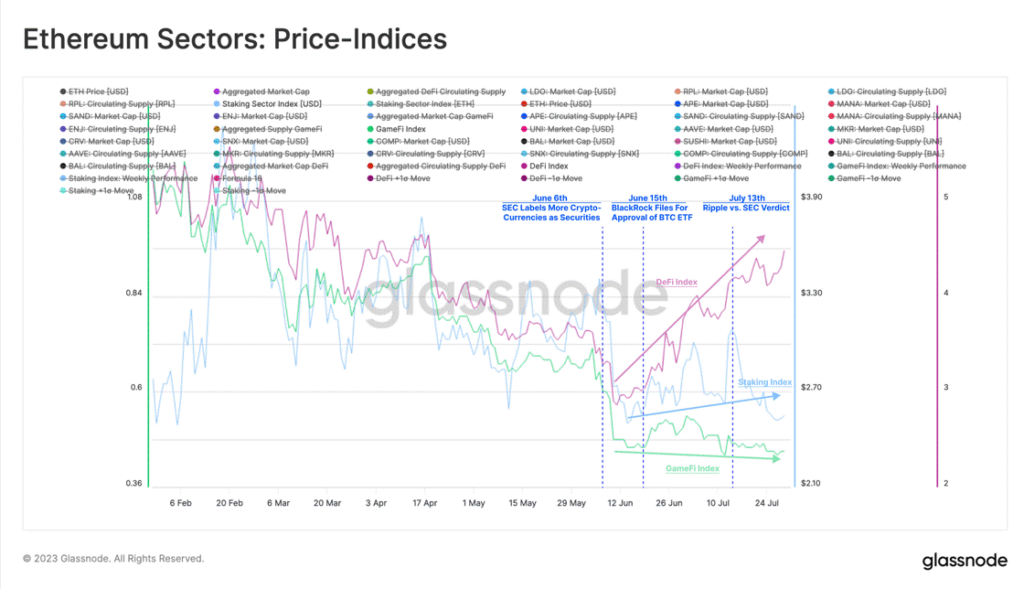
Source: Glassnode
• The Evolution of Polygon 2.0 as an Infrastructure Power House
The Polygon Foundation has revealed plans for the infrastructure of Polygon 2.0. This new network aims to unify various scaling services under a Layer 2 framework that uses Zero Knowledge technology for interoperability. The architecture has four main categories: Staking, Interoperability, Execution, and Proving, with emphasis on the first two. The staking layer will offer shared security like Polkadot and Cosmos, while interoperability focuses on native asset transfers across networks. Polygon will also upgrade its POS chain to a zkEVM network, using existing validators for submitting routing data to Ethereum.
Further, The MATIC token will transition to POL at a 1:1 ratio with uncapped supply and 2% yearly emissions to support staking and the ecosystem’s growth. Finally, Governance will be categorized into three branches to establish clear responsibilities for the stakeholders and form a treasury to help drive the growth of Polygon. The announcement, culminating Polygon’s 6-week program to unveil its new network design, saw a steady growth in total number of users and an increase of close to 100% in AuM on the new scaling solution, climbing from ~$23M to ~$55M, as shown below.
Figure 4: Polygon zkEVM scaling solution AuM
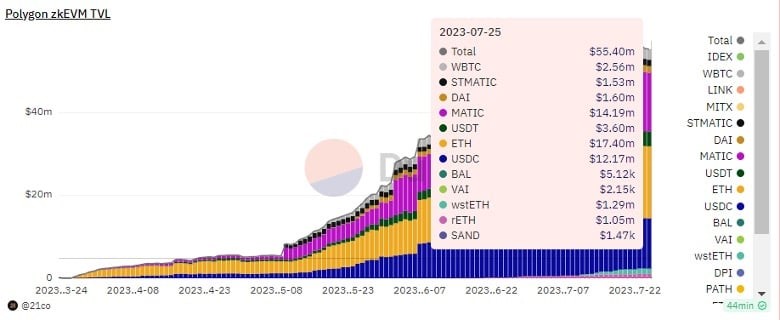
Source: 21shares on Dune
• A Rise in Institutional Adoption
With Europe’s first comprehensive legislation regulating cryptoassets (Markets in Crypto Assets) going into effect in 2024, the following instances speak volumes of the dire need for legal clarity to streamline the adoption of this asset class along with its underlying technology, especially for institutions.
• Societe Generale became the first company to receive a digital asset service provider (DASP) license in France. The license allows Forge, the bank’s cryptoasset division, to operate digital asset custody, sell and purchase digital assets for legal tender, and trade digital assets. In April, Forge launched CoinVertible (EURCV), an institutional-grade, euro-pegged stablecoin so far only built on the Ethereum blockchain, with plans to become blockchain-agnostic.
• Bank of Italy partnered with Polygon for a limited environment for trading securities on DeFi, tailored especially for institutions. Milano Hub, the bank’s innovation center, selected the “Institutional DeFi for Security Token Ecosystem Project”, an ecosystem project promoted by Cetif Advisory to research opportunities offered by DeFi and experiment with security tokens. This project is anticipated to act as a catalyst to onboard Italian banks, asset management companies, and other financial institutions into a DeFi platform that is fully compliant with regulatory requirements, which is the main obstacle to institutional adoption.
Figure 5: Breakdown of the RWA-backed assets issued by Institutions on the Polygon network
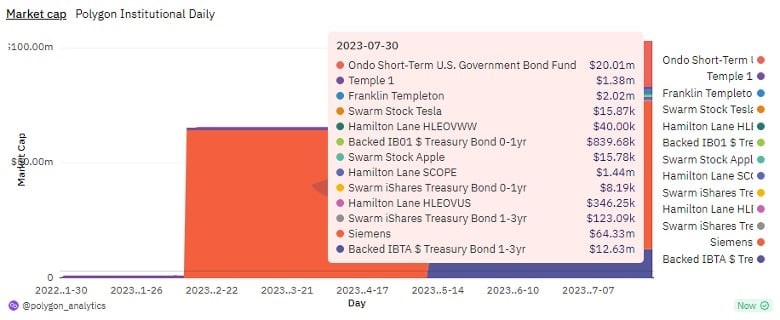
Source: Polygon Analytics on Dune
• Ethereum’s Scaling Solutions are Transitioning Towards Customizable Scalability
Allowing projects to deploy tailored applications as standalone networks enables customization of fee payments, permissions, and application development using various programming languages. Initiating this trend in early 2023, Arbitrum and Optimism introduced Orbit and OpStack, respectively, to bootstrap the creation of custom networks. OpStack emerged as the preferred solution, as it was adopted by major players like Coinbase, Binance, WorldCoin, and Zora, leveraging Optimism’s law of chains to promote seamless interoperability among OP-stack-based chains and addressing a crucial gap in crypto’s infrastructure. For context, Coinbase’s base network launched on July 13, securing close to $85M in total deposits in less than two weeks. Although the hype around meme coins drove the activity, the trend still demonstrates users’ excitement for Ethereum’s scaling future.
Figure 6: Gas Used by Scaling Solutions to Settle Transactions on Ethereum
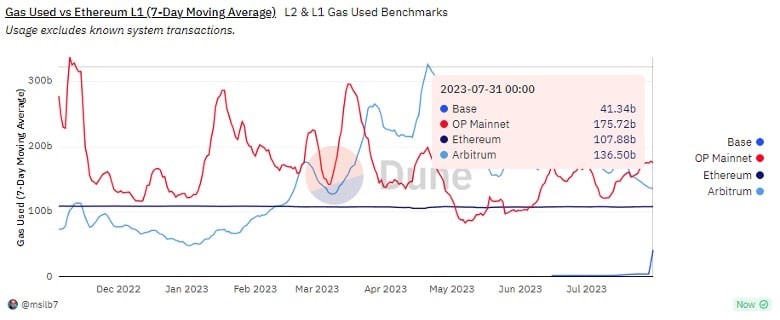
Source: @msiib7 on Dune
That said, ZkSync and Starkware entered the competition with ZKStack and Stark Net Stacks in July, offering customizable frameworks for embryonic networks to address their unique business needs. This development brings exciting prospects for programmable scalability and resolves privacy issues that are not easily achievable on Ethereum or its scaling solutions alone. Finally, the trend of embracing the Ethereum ecosystem was evident with Celo’s announced intent to pivot from an Ethereum competitor into an L2 anchored to Ethereum’s security. A decision that is driven by the need to benefit from the deep liquidity and vibrant developer ecosystem
What to Expect
• A Breakthrough in Resolving Cryptocurrency Infrastructure Challenges
Chainlink’s highly anticipated interoperability product finally launched on Mainnet. CCIP is an inter-blockchain communication standard that enables data and value transfer across four incompatible networks at the start. The solution incorporates four features to improve bridging: Active Risk Management (ARM) Network to detect and pause the malicious activity, programmatic transfers to automatically execute predefined instructions, rate limits for preventing unauthorized token transfers beyond a certain threshold, and smart execution to enable seamless cross-chain activities without extra payments using a pre-funded account. Check out our State of Crypto Issue 8 for a deeper dive into the technology.
CCIP is crucial in addressing weak security in cross-chain bridges, which have been exploited for nearly $2.5B in value over time. Thus, it’s a pivotal milestone to have an internet of contracts, similar to how the TCP/IP unified the global internet, facilitating liquidity to be globally accessible and the value of applications to flow across networks to be established on a battle-tested infrastructure that has enabled more than $8T in transactional value.
Further, CCIP may become Chainlink’s most significant product due to the wide need for interoperability. For context, applications using Chainlink’s CCIP can pay in LINK or ERC20 tokens, with a 10% premium on ERC20 to encourage LINK usage. This makes LINK a universal gas currency across chains, removing the need for token sales by node operators and phasing out the foundation’s subsidies. Finally, with a fee-based model in place, CCIP can generate sustainable earnings for DONs, the backbone of Chainlink’s security. That said, despite initial modest earnings of $35K over the past months, partnerships with Synthetic and Aave using CCIP for token transfers and cross-chain governance suggest significant growth potential. Integration with SWIFT also solidifies CCIP’s position as a cross-chain solution for both crypto and traditional finance.
Figure 7: Total Revenue Accrued by CCIP
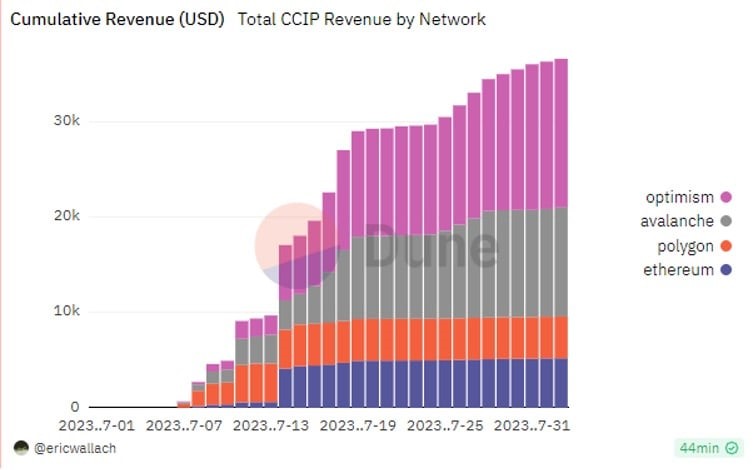
Source: @Ericwallach on Dune
• Solana Attempting to Claw Back
Although Solana faced a challenging start to the year due to FTX’s collapse, then the SEC’s legal actions against Coinbase and Binance, recent developments have hinted at a potential recovery. First, Solana Labs introduced Solang, enabling Ethereum developers to use Solidity (Ethereum’s programming language) on Solana, and GameShift, a web3 game development API streamlining the game development process. Then, Neon EVM went live, offering Ethereum-compatible smart contracts on Solana without significant code modifications.
Overall, Solana’s activity is showing signs of hopeful recovery, with active addresses rising 25% in the past seven weeks and total AuM hitting a year-high. Catalysts like Jump Crypto’s Firedancer, diversifying node software and combating outages, and demanding apps like Hiver and Teleport could drive excitement. Further, Saga, Solana’s phone device, might boost adoption as it abstracts the complexity of web3. Nonetheless, there’s still a lot of work to do to encourage users to move their capital back to Solana, especially as the total value transferred on the network remains at relatively muted levels.
Figure 8: Monthly Value moved on Solana
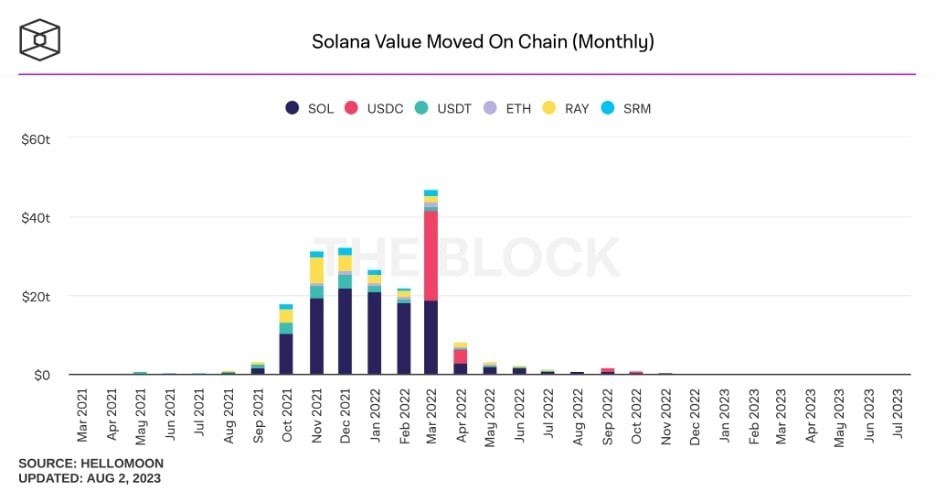
Source: TheBlock
• Ramifications of the Ripple Case
Although the court decision is inconclusive, we may see foundations and developers rethinking their strategies when bootstrapping their services and products to accommodate regulatory expectations, primarily concerning how their protocols achieve decentralization. It took Uniswap two years to launch its token after it had dedicated this time to focus on the fundamentals of the decentralized app, which is a tactic that has proved to pay off, building Uniswap to become the world’s largest decentralized exchange with more than $3B in assets under management and a market cap of almost $5B. More projects at the application layer could postpone token launches until they establish alignment between their product’s core services and market demand. Established projects may overhaul their entire business models to enhance token value capture. As discussed earlier in this report, we are already witnessing this shift with Polygon’s new tokenomics. Following Uniswap’s steps, entrepreneurs will focus their efforts on scoring investments from traditional players in venture capital and private equity instead of launching their tokens from the very start to raise funds.
Bookmarks
- Research Analyst Tom Wan’s insights were featured on Forkast News.
- Digging Into Ethereum Withdrawals and Future Improvements.
- Want to learn more about Ripple? Read our investment thesis.
- Celsius has been selling its assets as part of its bankruptcy proceedings.
- Learn more about Ethereum’s Liquid Staking Derivatives, which now constitute the largest DeFi sector by AUM and are expected to continue proliferating as the ETH staking ratio grows.
Next Month’s Calendar
These are the top events we’re closely monitoring in August.
• August 10: CPI data in the U.S.
• August 16: FOMC Meeting Minutes
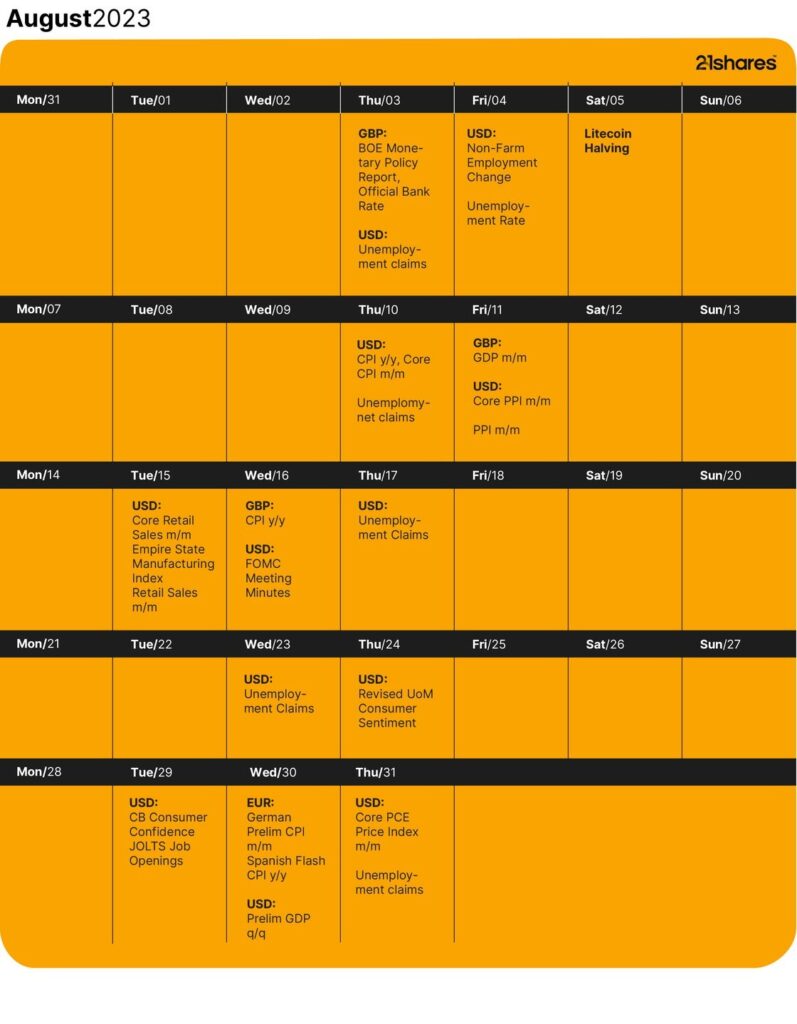
Source: 21shares, Forex Factory, CoinMarketCap
Research Newsletter
Each week the 21Shares Research team will publish our data-driven insights into the crypto asset world through this newsletter. Please direct any comments, questions, and words of feedback to research@21shares.com
Disclaimer
The information provided does not constitute a prospectus or other offering material and does not contain or constitute an offer to sell or a solicitation of any offer to buy securities in any jurisdiction. Some of the information published herein may contain forward-looking statements. Readers are cautioned that any such forward-looking statements are not guarantees of future performance and involve risks and uncertainties and that actual results may differ materially from those in the forward-looking statements as a result of various factors. The information contained herein may not be considered as economic, legal, tax or other advice and users are cautioned to base investment decisions or other decisions solely on the content hereof.
Du kanske gillar
-
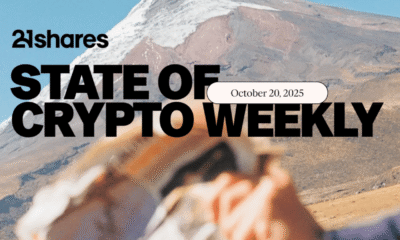

Bitcoin within 15% of its all-time high: Should you still allocate?
-
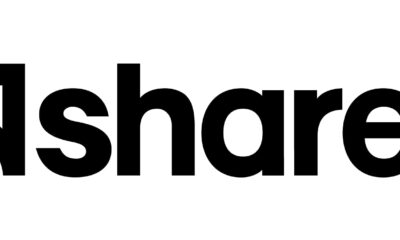

Globala krypto-ETPer förvaltade tillgångar når 250 miljarder dollar
-
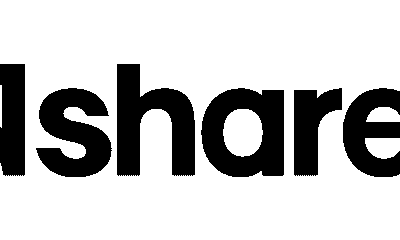

Record crypto liquidations amid tariff shock
-
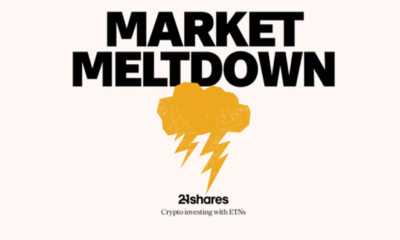

Crypto market update: record liquidations amid tariff shock
-
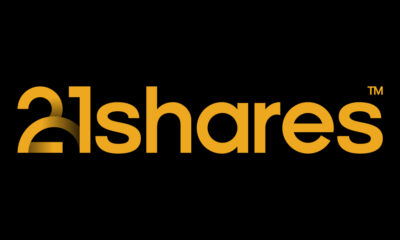

UK to drive more Bitcoin and Ethereum demand
-


Den verkliga halveringen

JPMorgan All Country Research Enhanced Index Equity Active UCITS ETF USD (dist) (JRWU ETF) med ISIN IE000JLILKH0 är en aktivt förvaltad börshandlad fond.
ETFen investerar i företag från utvecklade och tillväxtmarknader över hela världen och strävar efter att generera en högre avkastning än MSCI ACWI. Aktierna som ingår filtreras enligt ESG-kriterier (miljö, social och bolagsstyrning).
Den börshandlade fondens TER (total cost ratio) uppgår till 0,25 % p.a. JPMorgan All Country Research Enhanced Index Equity Active UCITS ETF USD (dist) är den billigaste ETF som följer JP Morgan All Country Research Enhanced Index Equity Active-index. ETFen replikerar det underliggande indexets prestanda genom full replikering (köper alla indexbeståndsdelar). Utdelningarna i ETFen delas ut till investerarna (kvartalsvis).
JPMorgan All Country Research Enhanced Index Equity Active UCITS ETF USD (dist) är en mycket liten ETF med tillgångar på 9 miljoner euro under förvaltning. Denna ETF lanserades den 10 december 2024 och har sin hemvist i Irland.
Investeringsmål
Delfondens mål är att uppnå en långsiktig avkastning som överstiger MSCI ACWI Index (”riktmärket”) genom att aktivt investera främst i en portfölj av stora och medelstora företag, globalt.
Riskprofil
- Värdet på din investering kan falla såväl som stiga och du kan få tillbaka mindre än du ursprungligen investerade.
- Värdet på aktierelaterade värdepapper kan sjunka såväl som upp som svar på enskilda företags resultat och allmänna marknadsförhållanden, ibland snabbt eller oförutsägbart. Om ett företag går i konkurs eller en liknande finansiell omstrukturering förlorar dess aktier vanligtvis det mesta eller hela sitt värde.
- Delfonden kan investera i värdepapper från mindre företag som kan vara mindre likvida, mer volatila och tenderar att bära större finansiell risk än värdepapper från större företag.
- Tillväxtmarknader kan utsättas för ökad politisk, regulatorisk och ekonomisk instabilitet, mindre utvecklade förvarings- och avvecklingsmetoder, dålig transparens och större finansiella risker. Tillväxtmarknadsvalutor kan vara föremål för volatila prisrörelser. Värdepapper på tillväxtmarknader kan också vara föremål för högre volatilitet och lägre likviditet än värdepapper på utvecklade marknader.
- Eftersom de instrument som innehas av delfonden kan vara denominerade i andra valutor än basvalutan, kan delfonden påverkas ogynnsamt av valutakontrollregler eller fluktuationer i valutakurser. Av denna anledning kan förändringar i valutakurser påverka värdet på delfondens portfölj och kan påverka värdet på andelarna.
- När det gäller osäkrade andelsklasser i en annan valuta än delfondens basvaluta kommer andelsklassens värde att vara föremål för valutarisk i förhållande till delfondens basvaluta.
- Hållbarhetsrisk kan ha en väsentlig negativ inverkan på en emittents finansiella ställning eller operativa resultat och därmed värdet på investeringen. Dessutom kan det öka delfondens volatilitet och/eller förstärka redan existerande risker för delfonden.
- Delfonden strävar efter att ge en avkastning över jämförelseindex; Delfonden kan dock prestera sämre än jämförelseindexet.
- Ytterligare information om risker finns i avsnittet ”Riskinformation” i prospektet.
Handla JRWU ETF
JPMorgan All Country Research Enhanced Index Equity Active UCITS ETF USD (dist) (JRWU ETF) är en europeisk börshandlad fond. Denna fond handlas på flera olika börser, till exempel Deutsche Boerse Xetra och London Stock Exchange.
Det betyder att det går att handla andelar i denna ETF genom de flesta svenska banker och Internetmäklare, till exempel DEGIRO, Nordnet, Aktieinvest och Avanza.
Börsnoteringar
| Börs | Valuta | Kortnamn |
| London Stock Exchange | GBX | JRUW |
| London Stock Exchange | USD | JRWU |
| SIX Swiss Exchange | USD | JRWU |
| XETRA | EUR | JRWU |
Största innehav
| Namn | ISIN | Land | Vikt % |
| JPM GL EM REI ESG UCITS ETF | IE00BF4G6Z54 | Irland | 9.32% |
| NVIDIA CORP | US67066G1040 | USA | 4.69% |
| APPLE INC | US0378331005 | USA | 4.56% |
| MICROSOFT CORP | US5949181045 | USA | 4.18% |
| AMAZON.COM INC | US0231351067 | USA | 2.92% |
| META PLATFORMS INC-CLASS A | US30303M1027 | USA | 1.91% |
| ALPHABET INC-CL A | US02079K3059 | USA | 1.46% |
| TESLA INC | US88160R1014 | USA | 1.35% |
| BROADCOM INC | US11135F1012 | USA | 1.19% |
| ALPHABET INC-CL C | US02079K1079 | USA | 1.18% |
Innehav kan komma att förändras
Nyheter
HANetf gör 8RMY till den enda försvars-ETFen enligt SFDR Artikel 8 i Europa
Publicerad
12 timmar sedanden
21 oktober, 2025![HANetf ändrar indexet för Future of European Defence UCITS ETF (ticker: 8RMY) för att klassificera den som SFDR Artikel 8, vilket ger exponering mot försvar. [1]](https://media.etfmarknaden.se/2025/10/8RMY-ETF.jpg)
- HANetf ändrar indexet för Future of European Defence UCITS ETF (ticker: 8RMY) för att klassificera den som SFDR Artikel 8, vilket ger exponering mot försvar. [1]
- ETFen fokuserar på europeiska NATO-medlemmars försvars- och cyberförsvarsutgifter och kommer att exkludera kontroversiella vapen – vilket breddar investerarbasen i hela Europa.
- Ändringen har gjorts för att möta europeiska investerares efterfrågan.
- HANetf erbjuder det bredaste utbudet av försvars-ETFer i Europa, som spänner över globala, europeiska och Indo-Stillahavsområdets exponeringar; deras globala försvars-ETF (ASWC) lanserades i juli 2023 och har sedan dess ackumulerat 3,13 miljarder dollar i förvaltat kapital. [2]
När du investerar i ETFer är ditt kapital i riskzonen. Digitala tillgångar kan vara mycket volatila.
HANetf, Europas första och ledande white-label UCITS ETF och ETC-plattform, [3] är glada att kunna meddela sin avsikt att ändra det underliggande indexet för Future of European Defence UCITS ETF (ticker: 8RMY) för att positionera fonden för Artikel 8-klassificering enligt Sustainable Finance Disclosure Regulation (SFDR). Detta skulle göra ARMY till den enda försvars-ETFen i Europa med denna status.
ETFen kommer att flytta från VettaFi Future of Defence Ex US Index till VettaFi European Future of Defence Screened Index. Ändringen syftar till att anpassa 8RMY till investerares önskan att få tillgång till det europeiska försvarstemat på ett ansvarsfullt sätt, utan att späda ut fondens kärnexponering. Det nya indexet begränsar behörigheten till företag med huvudkontor i europeiska NATO-länder och fokuserar portföljen på Europas försvarsindustriella bas.
Det nya indexet introducerar strikta undantag som täcker kontroversiella vapen och lägger till ytterligare ansvarskriterier, samtidigt som den välkända intäktsscreeningen och aktietaken bibehålls för att ge renodlad, diversifierad exponering mot det europeiska försvarstemat.
Dessa förbättringar är också avsedda att göra 8RMY mer tillgängligt för investerare i delar av Europa där ägandet av produkter med exponering mot kontroversiella vapen har begränsats. ARMY strävar efter att erbjuda en tydligare väg för investerare som söker försvarsexponering i linje med lokala policyer och preferenser.
Europa genomför en flerårig modernisering av sin försvarskapacitet, fyller på lager, skalar upp utrustningsupphandling och återuppbygger kapaciteten. 8RMY strävar efter att återspegla detta strukturella investeringstema samtidigt som vi höjer ribban för hur exponering levereras. Vi tror att 8RMY kommer att vara ett mycket effektivt verktyg för att hjälpa investerare att stödja den strategiskt viktiga europeiska försvarssektorn och göra det möjligt för det bredaste utbudet av investerare att göra det. Sedan vi lanserade 8RMY och NATO har vi fått feedback från en grupp investerare som behövde fler screeningar för att kunna investera.
HANetf har en gedigen meritlista inom försvarstema, efter att ha lanserat Future of Defence UCITS ETF (ticker: ASWC) i juli 2023, nu på 3,13 miljarder AUM. [4] Den fondens ramverk för NATO/NATO-allierade behörighet utformades för att hjälpa investerare att anpassa försvarsexponering till sina värderingar, med erkännande av att NATO enligt lag är en defensiv allians. Den planerade 8RMY-övergången bygger på denna erfarenhet.
Hector McNeil, medgrundare och VD för HANetf, kommenterade: ”Vi är mycket glada över att ta detta steg för att anpassa vår 8RMY ETF till SFDR artikel 8. Detta representerar ytterligare en viktig milstolpe i utvecklingen av försvarsinvesteringar i Europa. Investerare inser i allt högre grad att säkerhet och hållbarhet inte är motstridiga krafter – de är sammanlänkade. En välutrustad och ansvarsfullt styrd försvarssektor är avgörande för att upprätthålla fred, stabilitet och rättsstatsprincipen.
”Genom att anta ett mer fokuserat, granskat index strävar vi efter att ge investerare förtroende för att deras kapital stöder Europas legitima försvarskapacitet samtidigt som de följer robusta ansvarsstandarder. Viktigt är att dessa förbättringar också gör ETFen mer tillgänglig för investerare i regioner där exponering mot vissa försvarsrelaterade aktiviteter tidigare har begränsats, vilket breddar möjligheten att delta i Europas försvarsmodernisering.
”HANetf fortsätter att leda innovationen inom detta område och erbjuder produkter som inte bara fångar kraftfulla långsiktiga investeringsteman utan också återspeglar de europeiska investerarnas värderingar och regulatoriska förväntningar. Vi vill erbjuda europeiska investerare ett utmärkt och kurerat verktyg för att strategiskt stödja den europeiska försvarssektorn. Vi anser också att det är viktigt att vi som en renodlad europeisk leverantör erbjuder en ETF som inte kan påverkas av geopolitik utanför Europa.”
Handla ASWJ ETF
Future of Defence Indo-Pacific ex-China UCITS ETF (ticker: ASWJ) är en europeisk börshandlad fond. Denna fond handlas på flera olika börser, till exempel Deutsche Boerse Xetra och Euronext Paris. Av den anledningen förekommer olika kortnamn på samma börshandlade fond.
Det betyder att det går att handla andelar i denna ETF genom de flesta svenska banker och Internetmäklare, till exempel Nordnet, SAVR, DEGIRO och Avanza.
Handla 8RMY ETF
Future of European Defence UCITS ETF (ticker: 8RMY) är en europeisk börshandlad fond. Denna fond handlas på flera olika börser, till exempel Deutsche Boerse Xetra och Euronext Paris. Av den anledningen förekommer olika kortnamn på samma börshandlade fond.
Det betyder att det går att handla andelar i denna ETF genom de flesta svenska banker och Internetmäklare, till exempel Nordnet, SAVR, DEGIRO och Avanza.
Handla ASWC ETF
HANetf Future of Defence UCITS ETF (ASWC ETF) är en europeisk börshandlad fond. Denna fond handlas på flera olika börser, till exempel Deutsche Boerse Xetra och London Stock Exchange. Av den anledningen förekommer olika kortnamn på samma börshandlade fond.
Det betyder att det går att handla andelar i denna ETF genom de flesta svenska banker och Internetmäklare, till exempel Nordnet, SAVR, DEGIRO och Avanza.
[1] Hållbarhetsdokumentet kommer att finnas tillgängligt på webbplatsen inom kort.
[2] Bredaste sortiment som visas i ETF-databasen per den 21 oktober 2025. AUM kommer från HANetf och Bloomberg per den 15 oktober 2025.
[3] Som visas i ETF-databasen.
Nyheter
DSPY ETP ger exponering mot S&P500 och utdelning varje månad
Publicerad
13 timmar sedanden
21 oktober, 2025
IncomeShares S&P 500 Options (0DTE) ETP (DSPY ETP) med ISIN XS2875106242, är en aktivt förvaltad börshandlad produkt.
ETP-strategin är att ge exponering mot S&P 500 och sälja säljoptioner på S&P 500-indexet eller SPDR S&P 500 ETF Trust för att generera premier.
ETNens totala kostnadskvot (TER) uppgår till 0,45 % per år. Utdelningen i ETNen delas ut till investerarna (månadsvis).
IncomeShares S&P 500 Options (0DTE) ETP är en mycket liten ETN med 5 miljoner euro i förvaltat kapital. Denna ETF lanserades den 27 augusti 2024 och har sitt säte i Irland.
Varför S&P500-optioner ETP?
Investeringsstrategin syftar till att generera månatliga intäkter genom att sälja dagliga säljoptioner på S&P500-indexet eller SPDR S&P 500 ETF Trust med dagligt utgångsdatum för optioner och betala avkastning på de innehavda kontanterna. ETP-värdepapperen syftar till att generera avkastning, samtidigt som de bibehåller uppåtgående exponering upp till optionernas lösenpris.
Kapital i riskzonen. Du kan förlora en del av eller hela din investering.
Handla DSPY ETP
IncomeShares S&P 500 Options (0DTE) ETP (DSPY ETP) är en europeisk börshandlad produkt. Denna ETPhandlas på flera olika börser, till exempel Deutsche Boerse Xetra och London Stock Exchange.
Det betyder att det går att handla andelar i denna ETP genom de flesta svenska banker och Internetmäklare, till exempel Nordnet, SAVR, DEGIRO och Avanza.
Börsnoteringar

JRWU ETF är en aktivt förvaltad globalfond
![HANetf ändrar indexet för Future of European Defence UCITS ETF (ticker: 8RMY) för att klassificera den som SFDR Artikel 8, vilket ger exponering mot försvar. [1]](https://media.etfmarknaden.se/2025/10/8RMY-ETF-80x80.jpg)
HANetf gör 8RMY till den enda försvars-ETFen enligt SFDR Artikel 8 i Europa

DSPY ETP ger exponering mot S&P500 och utdelning varje månad

33GI ETF köper bara eurodenominerade företagsobligationer som förfaller 2033

Tre nya börshandlade fonder från Xtrackers

Fokus mot en helt ny börshandlad produkt i september 2025

M5TYs senaste utdelningstakt (55 %) belyser covered call-strategins inkomstpotential

Could Bitcoin be the key to your dream house?

Börshandlade fonder för europeiska small caps

Levler noterar ytterligare fyra börshandlade fonder i Sverige
Populära
-

 Nyheter3 veckor sedan
Nyheter3 veckor sedanFokus mot en helt ny börshandlad produkt i september 2025
-
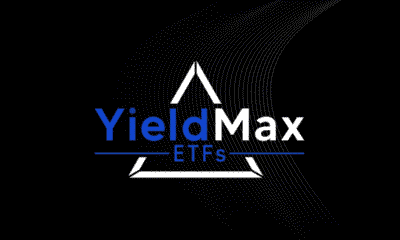
 Nyheter4 veckor sedan
Nyheter4 veckor sedanM5TYs senaste utdelningstakt (55 %) belyser covered call-strategins inkomstpotential
-
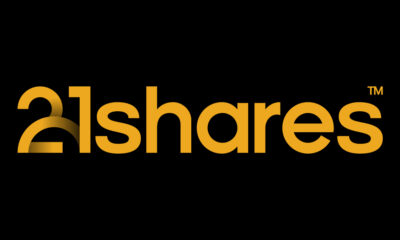
 Nyheter4 veckor sedan
Nyheter4 veckor sedanCould Bitcoin be the key to your dream house?
-
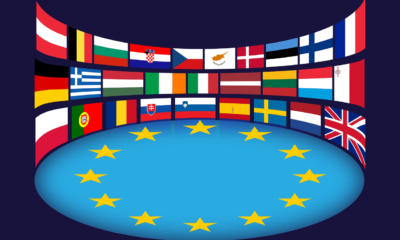
 Nyheter3 veckor sedan
Nyheter3 veckor sedanBörshandlade fonder för europeiska small caps
-
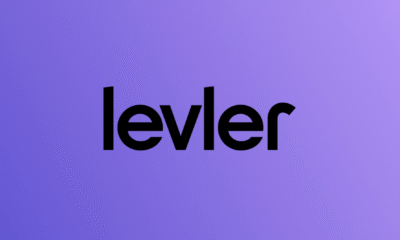
 Nyheter2 veckor sedan
Nyheter2 veckor sedanLevler noterar ytterligare fyra börshandlade fonder i Sverige
-

 Nyheter3 veckor sedan
Nyheter3 veckor sedanMiners Find Their Mojo as Gold Consolidates
-

 Nyheter4 veckor sedan
Nyheter4 veckor sedanTech multi-megatrend ETF utvecklar metodologi med tillägg av exponeringar mot kvantberäkning och försvarsteknik
-

 Nyheter4 veckor sedan
Nyheter4 veckor sedanState Street och Blackstone lanserar aktivt förvaltade CLO-ETFer i Europa


